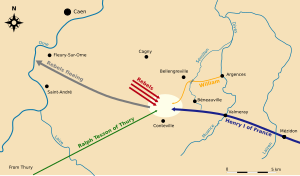Battle of Val-ès-Dunes
| date | 1047 |
|---|---|
| place | near Conteville , Normandy |
| output | Norman-French victory |
| Parties to the conflict | |
|---|---|
|
Kingdom of France |
Norman rebels |
| Commander | |
| Troop strength | |
| 10,000 French, unknown number of Normans |
25,000 men |
The Battle of Val-ès-Dunes took place in France in 1047 . The combined armies of Duke William the Bastard and King Henry I of France fought against several rebellious Norman barons led by Guy of Burgundy . Wilhelm (later called "the Conqueror" after the conquest of England in 1066) was able to regain his title after a victorious battle and control the western part of his duchy.
prehistory
Wilhelm, the illegitimate son of Duke Robert I of Normandy , received the title in 1035 as a seven-year-old boy. Although other nobles, such as B. his cousin Guy of Burgundy, who thought they were entitled to the title, Wilhelm received it, not least because King Henry I and other influential nobles supported this.
In 1046, Wilhelm’s competitors decided to change this. After Wilhelm escaped an attack near the town of Valognes on the Cotentin Peninsula, the rebellious nobles, Guy of Burgundy, Nigel of Cotentin, Rannulf of Bessin, Ralph Tesson of Thury, Grimoald of Plessis and Haimo of Creully joined forces and raised one Army of 25,000 soldiers.
After the attack on him, Wilhelm rode straight to King Heinrich's court in Poissy and reminded the king that a revolt against a devoted vassal of the king would also be an attack on the king himself. King Heinrich was persuaded and sent an army of 10,000 men to Normandy .
The battle
In January (summer according to other sources) 1047, the royal army and Wilhelm's much smaller Norman army joined forces in the heart of the rebellious territory near Caen . Ralph Tesson and his soldiers switched sides and also joined the royal army. The next day the opposing armies met on the Val-ès-Dunes plain , near what is now the city of Conteville .
The battle consisted mainly of a number of smaller cavalry skirmishes. The rebel army outnumbered the royal army, but it was uncoordinated and poorly managed. After losing a few skirmishes in which u. a. Haimo was killed by Creully, the rebel army panicked and fled west. The royal army pursued the fleeing rebels, killing thousands of them. They were driven into the Orne , near the ford of Athis-de-l'Orne near Fleury-sur-Orne . Observers of these incidents were talking about that the number of floating corpses in the river was so great that it downstream the water mill of Barbillon blocked.
After the battle
While the royal army pursued the main part of the rebel army to the west, Guy of Burgundy was able to flee with his surviving men to his lands in the east, where he holed up in the strategically located castle of Brionne . Although Wilhelm besieged the castle intensively , it took until 1050 until it was conquered. Until then, Wilhelm could not exercise any control over the eastern parts of his duchy behind Brionne.
After the Battle of Val-és-Dunes there was still strong opposition to Wilhelm among the nobles, but this did not come to light in open aggression. Finally, in October 1047, a so-called " peace before God " was concluded between the parties. This peace treaty, which was also demanded and monitored by the church, gave Wilhelm special rights with which he could protect his title and maintain public order. William pardoned a number of barons who had fought against him, but Guy of Burgundy remained a constant threat. It then took five years before the next revolt broke out.
See also
literature
David C. Douglas - William the Conqueror: The Norman Impact upon England . Berkeley, Calif. : University of California, 1964.
